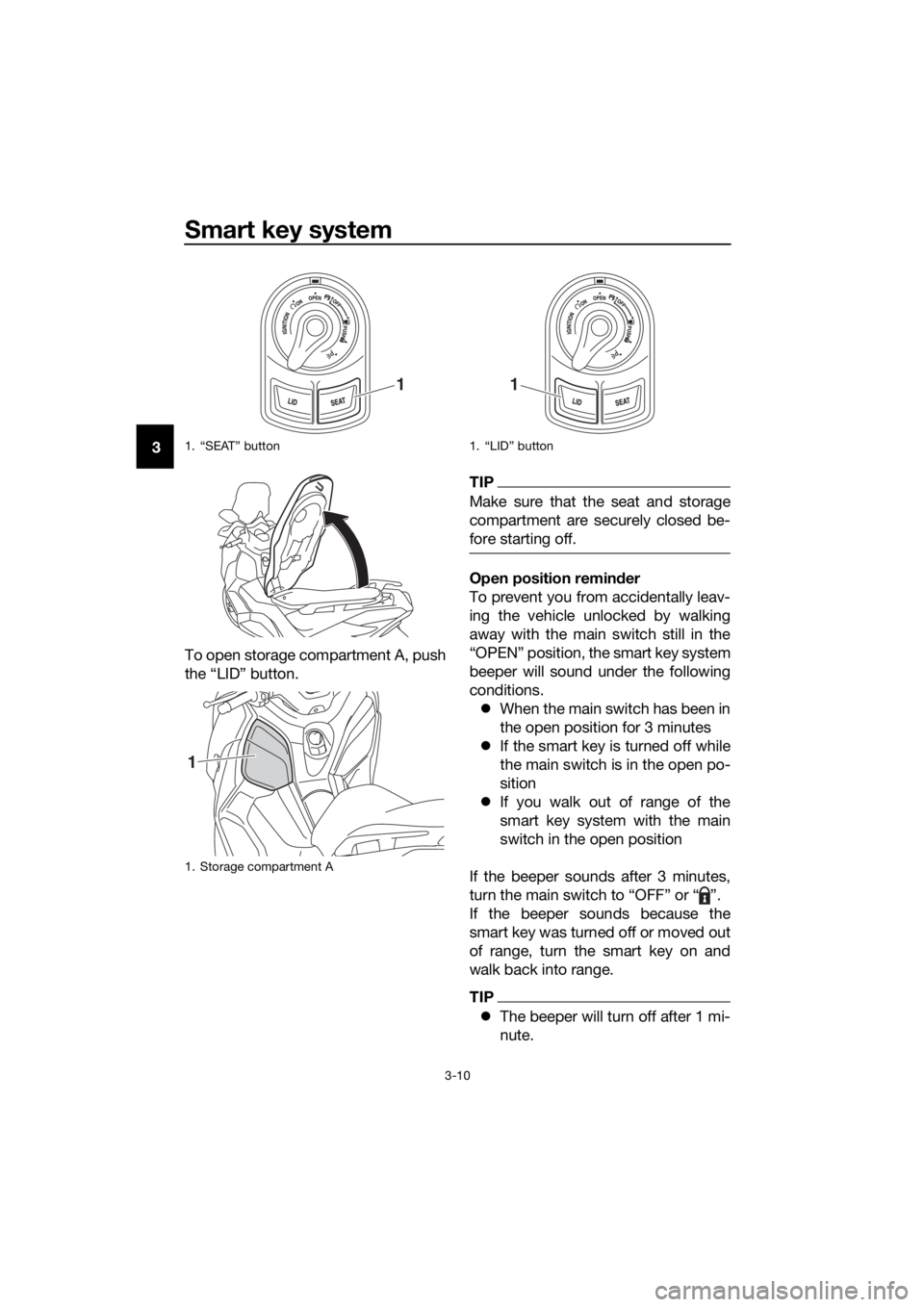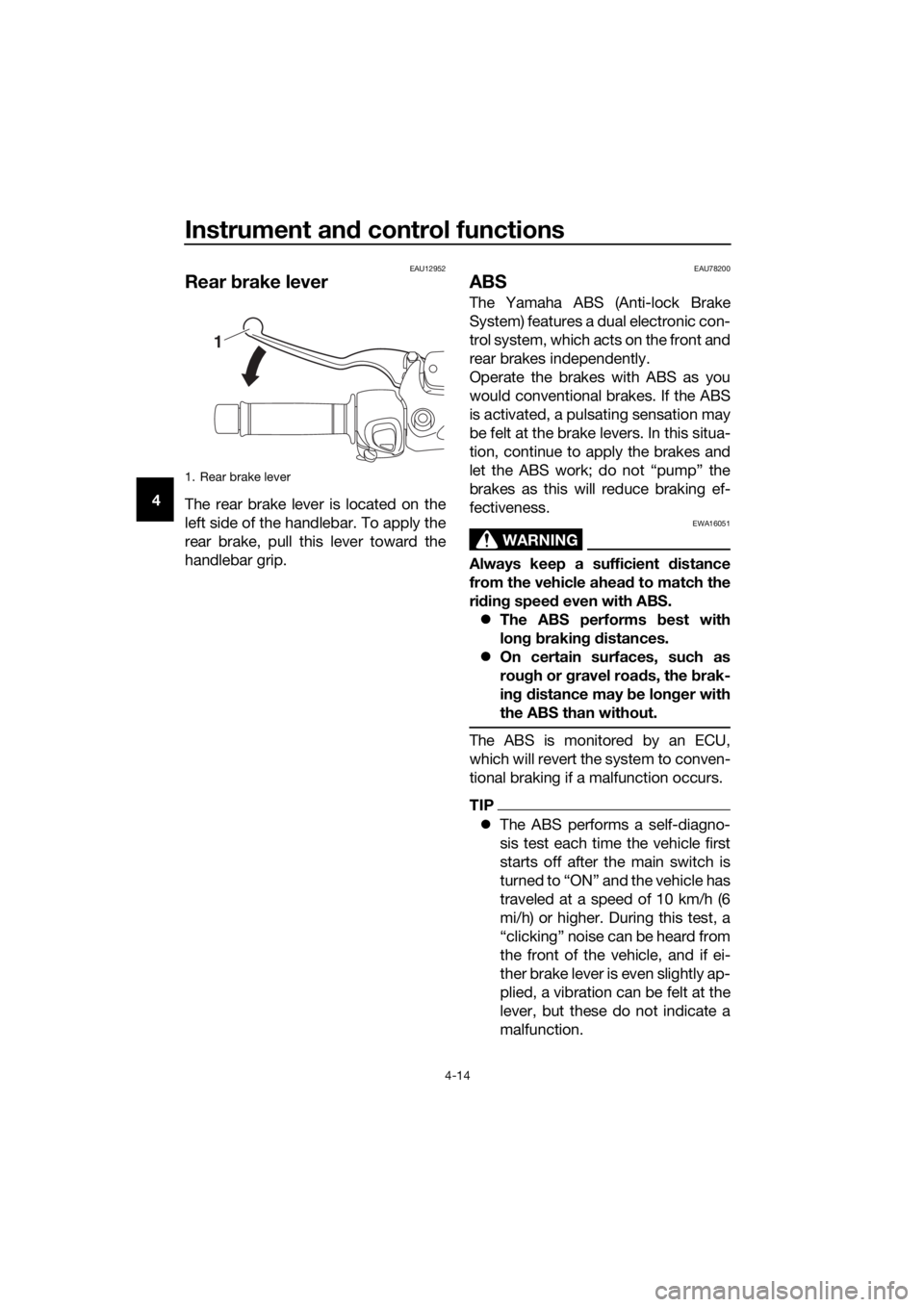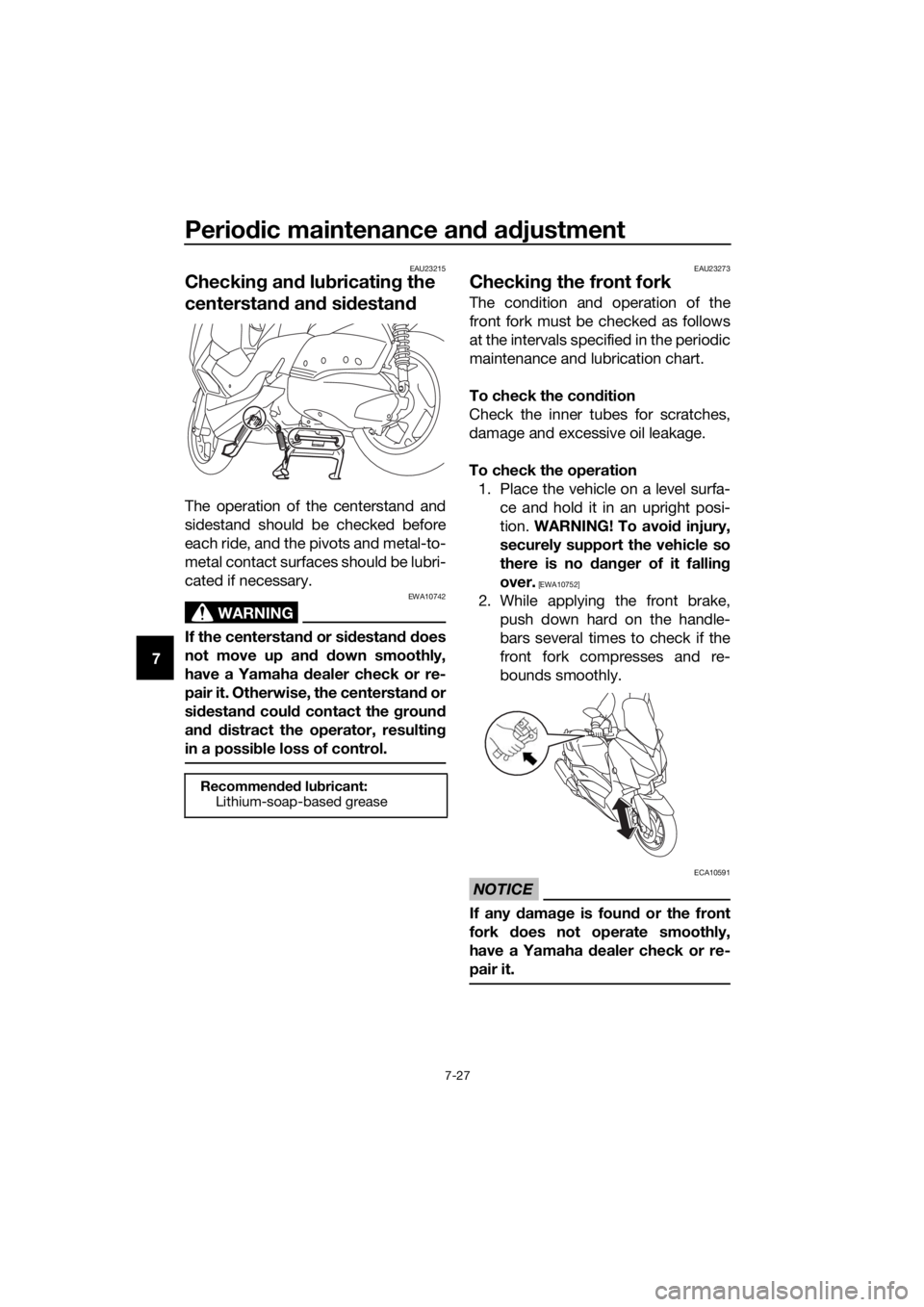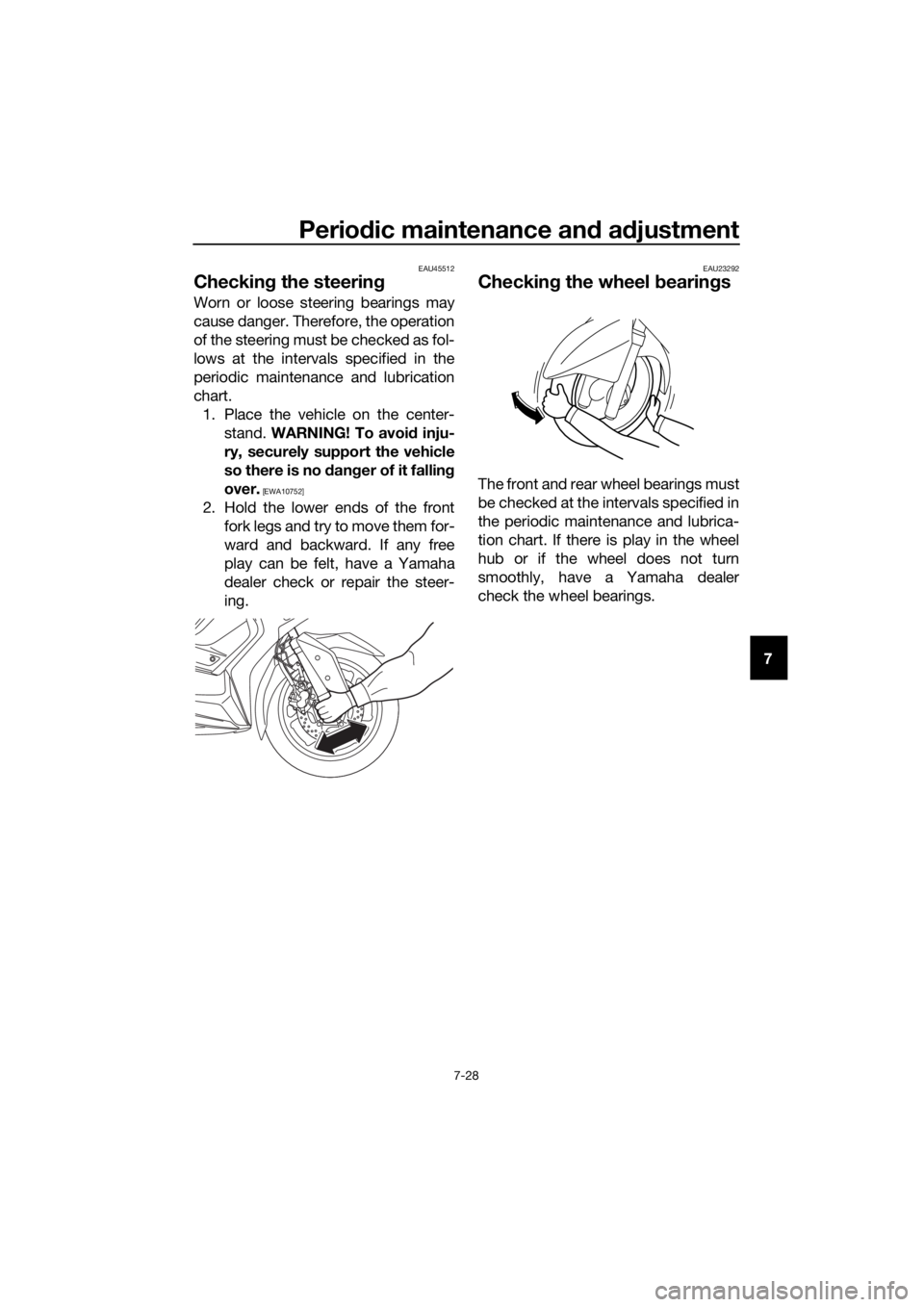2017 YAMAHA XMAX 300 ECU
[x] Cancel search: ECUPage 9 of 116

Safety information
1-3
1
engine exhaust. Deadly levels of car-
bon monoxide can collect rapidly and
you can quickly be overcome and un-
able to save yourself. Also, deadly lev-
els of carbon monoxide can linger for
hours or days in enclosed or poorly
ventilated areas. If you experience any
symptoms of carbon monoxide poi-
soning, leave the area immediately, get
fresh air, and SEEK MEDICAL TREAT-
MENT.
�z Do not run engine indoors. Even if
you try to ventilate engine exhaust
with fans or open windows and
doors, carbon monoxide can rap-
idly reach dangerous levels.
�z Do not run engine in poorly venti-
lated or partially enclosed areas
such as barns, garages, or car-
ports.
�z Do not run engine outdoors where
engine exhaust can be drawn into
a building through openings such
as windows and doors.
Loa din g
Adding accessories or cargo to your
scooter can adversely affect stability
and handling if the weight distribution
of the scooter is changed. To avoid the
possibility of an accident, use extreme
caution when adding cargo or acces-
sories to your scooter. Use extra care
when riding a scooter that has added
cargo or accessories. Here, along with
the information about accessories be-
low, are some general guidelines to fol-
low if loading cargo to your scooter: The total weight of the operator, pas-
senger, accessories and cargo must
not exceed the maximum load limit.
Operation of an overloa
ded vehicle
coul d cause an acci dent.
When loading within this weight limit,
keep the following in mind: �z Cargo and accessory weight
should be kept as low and close to
the scooter as possible. Securely
pack your heaviest items as close
to the center of the vehicle as pos-
sible and make sure to distribute
the weight as evenly as possible
on both sides of the scooter to
minimize imbalance or instability.
�z Shifting weights can create a sud-
den imbalance. Make sure that
accessories and cargo are se-
curely attached to the scooter be-
fore riding. Check accessory
mounts and cargo restraints fre-
quently.
• Properly adjust the suspension for your load (suspension-ad-
justable models only), and
check the condition and pres-
sure of your tires.
• Never attach any large or heavy items to the handlebar, front
fork, or front fender. Such items
can create unstable handling or
a slow steering response.
�z This vehicle is not desi gne d to
pull a trailer or to be attached to
a si decar.
Maximum loa d:
161 kg (355 lb)
UB74E0E0.book Page 3 Tuesday, May 2, 2017 1:04 PM
Page 11 of 116

Safety information
1-5
1
Aftermarket Tires an
d Rims
The tires and rims that came with your
scooter were designed to match the
performance capabilities and to pro-
vide the best combination of handling,
braking, and comfort. Other tires, rims,
sizes, and combinations may not be
appropriate. Refer to page 7-19 for tire
specifications and more information on
replacing your tires.
Transportin g the Scooter
Be sure to observe following instruc-
tions before transporting the scooter in
another vehicle. �z Remove all loose items from the
scooter.
�z Point the front wheel straight
ahead on the trailer or in the truck
bed, and choke it in a rail to pre-
vent movement.
�z Secure the scooter with tie-downs
or suitable straps that are at-
tached to solid parts of the scoot-
er, such as the frame or upper
front fork triple clamp (and not, for
example, to rubber-mounted han-
dlebars or turn signals, or parts
that could break). Choose the lo-
cation for the straps carefully so
the straps will not rub against
painted surfaces during transport.
�z The suspension should be com-
pressed somewhat by the tie-
downs, if possible, so that the
scooter will not bounce exces-
sively during transport.
EAU57600
Further safe-ri din g points
�z Be sure to signal clearly when
making turns.
�z Braking can be extremely difficult
on a wet road. Avoid hard braking,
because the scooter could slide.
Apply the brakes slowly when
stopping on a wet surface.
�z Slow down as you approach a
corner or turn. Once you have
completed a turn, accelerate
slowly.
�z Be careful when passing parked
cars. A driver might not see you
and open a door in your path.
�z Railroad crossings, streetcar rails,
iron plates on road construction
sites, and manhole covers be-
come extremely slippery when
wet. Slow down and cross them
with caution. Keep the scooter up-
right, otherwise it could slide out
from under you.
�z The brake pads or linings could
get wet when you wash the scoot-
er. After washing the scooter,
check the brakes before riding.
�z Always wear a helmet, gloves,
trousers (tapered around the cuff
and ankle so they do not flap), and
a brightly colored jacket.
�z Do not carry too much luggage on
the scooter. An overloaded scoot-
er is unstable. Use a strong cord
to secure any luggage to the carri-
er (if equipped). A loose load will
affect the stability of the scooter
and could divert your attention
from the road. (See page 1-3.)
UB74E0E0.book Page 5 Tuesday, May 2, 2017 1:04 PM
Page 24 of 116

Smart key system
3-10
3To open storage compartment A, push
the “LID” button.
TIP
Make sure that the seat and storage
compartment are securely closed be-
fore starting off.
Open position remin der
To prevent you from accidentally leav-
ing the vehicle unlocked by walking
away with the main switch still in the
“OPEN” position, the smart key system
beeper will sound under the following
conditions. �z When the main switch has been in
the open position for 3 minutes
�z If the smart key is turned off while
the main switch is in the open po-
sition
�z If you walk out of range of the
smart key system with the main
switch in the open position
If the beeper sounds after 3 minutes,
turn the main switch to “OFF” or “ ”.
If the beeper sounds because the
smart key was turned off or moved out
of range, turn the smart key on and
walk back into range.
TIP
�z The beeper will turn off after 1 mi-
nute.
1. “SEAT” button
1. Storage compartment A
1
1
1. “LID” button
1
UB74E0E0.book Page 10 Tuesday, May 2, 2017 1:04 PM
Page 40 of 116

Instrument and control functions
4-14
4
EAU12952
Rear brake lever
The rear brake lever is located on the
left side of the handlebar. To apply the
rear brake, pull this lever toward the
handlebar grip.
EAU78200
ABS
The Yamaha ABS (Anti-lock Brake
System) features a dual electronic con-
trol system, which acts on the front and
rear brakes independently.
Operate the brakes with ABS as you
would conventional brakes. If the ABS
is activated, a pulsating sensation may
be felt at the brake levers. In this situa-
tion, continue to apply the brakes and
let the ABS work; do not “pump” the
brakes as this will reduce braking ef-
fectiveness.
WARNING
EWA16051
Always keep a sufficient d istance
from the vehicle ahead to match the
ri din g speed even with ABS.
�z The ABS performs b est with
lon g b rakin g d istances.
�z On certain surfaces, such as
rou gh or g ravel roa ds, the b rak-
in g d istance may be lon ger with
the ABS than without.
The ABS is monitored by an ECU,
which will revert the system to conven-
tional braking if a malfunction occurs.
TIP
�z The ABS performs a self-diagno-
sis test each time the vehicle first
starts off after the main switch is
turned to “ON” and the vehicle has
traveled at a speed of 10 km/h (6
mi/h) or higher. During this test, a
“clicking” noise can be heard from
the front of the vehicle, and if ei-
ther brake lever is even slightly ap-
plied, a vibration can be felt at the
lever, but these do not indicate a
malfunction.
1. Rear brake lever
1
UB74E0E0.book Page 14 Tuesday, May 2, 2017 1:04 PM
Page 44 of 116

Instrument and control functions
4-18
4
EAU13213
Fuel
Make sure there is sufficient gasoline in
the tank.
WARNING
EWA10882
Gasoline an d g asoline vapors are
extremely flamma ble. To avoi d fires
an d explosions an d to re duce the
risk of injury when refuelin g, follow
these instructions.
1. Before refueling, turn off the en- gine and be sure that no one is sit-
ting on the vehicle. Never refuel
while smoking, or while in the vi-
cinity of sparks, open flames, or
other sources of ignition such as
the pilot lights of water heaters
and clothes dryers.
2. Do not overfill the fuel tank. Stop filling when the fuel reaches the
bottom of the filler tube. Because
fuel expands when it heats up,
heat from the engine or the sun
can cause fuel to spill out of the
fuel tank.
3. Wipe up any spilled fuel immedi- ately. NOTICE: Immediately
wipe off spille d fuel with a clean, d
ry, soft cloth, since fuel may
d eteriorate painte d surfaces or
plastic parts.
[ECA10072]
4. Be sure to securely close the fuel tank cap.
WARNING
EWA15152
Gasoline is poisonous an d can cau-
se injury or death. Han dle gasoline
with care. Never siphon gasoline by
mouth. If you shoul d swallow some
g asoline or inhale a lot of gasoline
vapor, or get some g asoline in your
eyes, see your doctor imme diately. If
g asoline spills on your skin, wash
with soap an d water. If gasoline
spills on your clothin g, chan ge your
clothes.
EAU76750
NOTICE
ECA11401
Use only unlea ded g asoline. The use
of lead ed g asoline will cause severe
d amag e to internal en gine parts,
such as the valves an d piston rin gs,
as well as to the exhaust system.
1. Fuel tank filler tube
2. Maximum fuel level
1 2
Recommen ded fuel:
Regular unleaded gasoline (Gasohol
[E10] acceptable)
Fuel tank capacity: 13 L (3.4 US gal, 2.9 Imp.gal)
UB74E0E0.book Page 18 Tuesday, May 2, 2017 1:04 PM
Page 77 of 116

Periodic maintenance an d a djustment
7-14
7
b
e protecte d a gainst frost an d
corrosion. If water has b een
a dde d to the coolant, have a
Yamaha dealer check the anti-
freeze content of the coolant as
soon as possi ble, otherwise the
effectiveness of the coolant will
b e red uced.
[ECA10473]
6. Install the coolant reservoir cover.
7. Place the left floorboard mat in the
original position and push it down-
ward to secure it.
EAU33032Chan gin g the coolant
The coolant must be changed at the in-
tervals specified in the periodic mainte-
nance and lubrication chart. Have a
Yamaha dealer change the coolant.
WARNING! Never attempt to remove the ra diator cap when the en gine is
hot.
[EWA10382] EAU78573
Air filter an
d V- belt case air fil-
ter elements
The air filter element and the sub air fil-
ter element should be replaced every
20000 km (12000 mi). The pre air filter
element and the V-belt case air filter el-
ement should be cleaned at the inter-
vals specified in the periodic
maintenance and lubrication chart.
Service the air filter elements more fre-
quently if you are riding in unusually
wet or dusty areas. The air filter check
hose must be frequently checked and
cleaned if necessary.
Cleanin g the air filter check hose
1. Check the hose on the rear side of the air filter case for accumulated
dirt or water.
2. If dirt or water is visible, remove the hose from the clamp, clean it,
and then install it.
TIP
If dirt or water was found in the check
hose, be sure to check the air filter ele-
ment for excessive dirt or damage and
replace it if necessary.
1. Coolant reservoir cap
Coolant reservoir capacity (up to
the maximum level mark):0.18 L (0.19 US qt, 0.16 Imp.qt)
1
1. Air filter check hose
1
UB74E0E0.book Page 14 Tuesday, May 2, 2017 1:04 PM
Page 90 of 116

Periodic maintenance an d a djustment
7-27
7
EAU23215
Checkin g an d lu bricatin g the
centerstan d an d si destan d
The operation of the centerstand and
sidestand should be checked before
each ride, and the pivots and metal-to-
metal contact surfaces should be lubri-
cated if necessary.
WARNING
EWA10742
If the centerstan d or si destan d d oes
not move up an d d own smoothly,
have a Yamaha dealer check or re-
pair it. Otherwise, the centerstan d or
si destan d coul d contact the groun d
an d d istract the operator, resultin g
in a possi ble loss of control.
EAU23273
Checkin g the front fork
The condition and operation of the
front fork must be checked as follows
at the intervals specified in the periodic
maintenance and lubrication chart.
To check the con dition
Check the inner tubes for scratches,
damage and excessive oil leakage.
To check the operation 1. Place the vehicle on a level surfa- ce and hold it in an upright posi-
tion. WARNING! To avoi d injury,
securely support the vehicle so
there is no d anger of it fallin g
over.
[EWA10752]
2. While applying the front brake, push down hard on the handle-
bars several times to check if the
front fork compresses and re-
bounds smoothly.
NOTICE
ECA10591
If any damag e is foun d or the front
fork does not operate smoothly,
have a Yamaha dealer check or re-
pair it.
Recommen ded lu bricant:
Lithium-soap-based grease
UB74E0E0.book Page 27 Tuesday, May 2, 2017 1:04 PM
Page 91 of 116

Periodic maintenance an d a djustment
7-28
7
EAU45512
Checkin g the steerin g
Worn or loose steering bearings may
cause danger. Therefore, the operation
of the steering must be checked as fol-
lows at the intervals specified in the
periodic maintenance and lubrication
chart.
1. Place the vehicle on the center- stand. WARNING! To avoi d inju-
ry, securely support the vehicle
so there is no dan ger of it fallin g
over.
[EWA10752]
2. Hold the lower ends of the front fork legs and try to move them for-
ward and backward. If any free
play can be felt, have a Yamaha
dealer check or repair the steer-
ing.
EAU23292
Checkin g the wheel bearin gs
The front and rear wheel bearings must
be checked at the intervals specified in
the periodic maintenance and lubrica-
tion chart. If there is play in the wheel
hub or if the wheel does not turn
smoothly, have a Yamaha dealer
check the wheel bearings.
UB74E0E0.book Page 28 Tuesday, May 2, 2017 1:04 PM